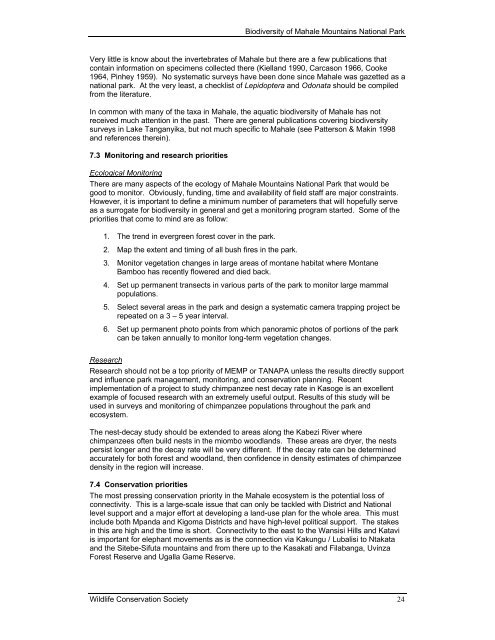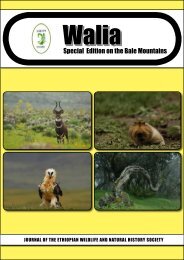Biodiversity of Mahale Mountains National Park, Tanzania | Report ...
Biodiversity of Mahale Mountains National Park, Tanzania | Report ...
Biodiversity of Mahale Mountains National Park, Tanzania | Report ...
You also want an ePaper? Increase the reach of your titles
YUMPU automatically turns print PDFs into web optimized ePapers that Google loves.
<strong>Biodiversity</strong> <strong>of</strong> <strong>Mahale</strong> <strong>Mountains</strong> <strong>National</strong> <strong>Park</strong><br />
Very little is know about the invertebrates <strong>of</strong> <strong>Mahale</strong> but there are a few publications that<br />
contain information on specimens collected there (Kielland 1990, Carcason 1966, Cooke<br />
1964, Pinhey 1959). No systematic surveys have been done since <strong>Mahale</strong> was gazetted as a<br />
national park. At the very least, a checklist <strong>of</strong> Lepidoptera and Odonata should be compiled<br />
from the literature.<br />
In common with many <strong>of</strong> the taxa in <strong>Mahale</strong>, the aquatic biodiversity <strong>of</strong> <strong>Mahale</strong> has not<br />
received much attention in the past. There are general publications covering biodiversity<br />
surveys in Lake Tanganyika, but not much specific to <strong>Mahale</strong> (see Patterson & Makin 1998<br />
and references therein).<br />
7.3 Monitoring and research priorities<br />
Ecological Monitoring<br />
There are many aspects <strong>of</strong> the ecology <strong>of</strong> <strong>Mahale</strong> <strong>Mountains</strong> <strong>National</strong> <strong>Park</strong> that would be<br />
good to monitor. Obviously, funding, time and availability <strong>of</strong> field staff are major constraints.<br />
However, it is important to define a minimum number <strong>of</strong> parameters that will hopefully serve<br />
as a surrogate for biodiversity in general and get a monitoring program started. Some <strong>of</strong> the<br />
priorities that come to mind are as follow:<br />
1. The trend in evergreen forest cover in the park.<br />
2. Map the extent and timing <strong>of</strong> all bush fires in the park.<br />
3. Monitor vegetation changes in large areas <strong>of</strong> montane habitat where Montane<br />
Bamboo has recently flowered and died back.<br />
4. Set up permanent transects in various parts <strong>of</strong> the park to monitor large mammal<br />
populations.<br />
5. Select several areas in the park and design a systematic camera trapping project be<br />
repeated on a 3 – 5 year interval.<br />
6. Set up permanent photo points from which panoramic photos <strong>of</strong> portions <strong>of</strong> the park<br />
can be taken annually to monitor long-term vegetation changes.<br />
Research<br />
Research should not be a top priority <strong>of</strong> MEMP or TANAPA unless the results directly support<br />
and influence park management, monitoring, and conservation planning. Recent<br />
implementation <strong>of</strong> a project to study chimpanzee nest decay rate in Kasoge is an excellent<br />
example <strong>of</strong> focused research with an extremely useful output. Results <strong>of</strong> this study will be<br />
used in surveys and monitoring <strong>of</strong> chimpanzee populations throughout the park and<br />
ecosystem.<br />
The nest-decay study should be extended to areas along the Kabezi River where<br />
chimpanzees <strong>of</strong>ten build nests in the miombo woodlands. These areas are dryer, the nests<br />
persist longer and the decay rate will be very different. If the decay rate can be determined<br />
accurately for both forest and woodland, then confidence in density estimates <strong>of</strong> chimpanzee<br />
density in the region will increase.<br />
7.4 Conservation priorities<br />
The most pressing conservation priority in the <strong>Mahale</strong> ecosystem is the potential loss <strong>of</strong><br />
connectivity. This is a large-scale issue that can only be tackled with District and <strong>National</strong><br />
level support and a major effort at developing a land-use plan for the whole area. This must<br />
include both Mpanda and Kigoma Districts and have high-level political support. The stakes<br />
in this are high and the time is short. Connectivity to the east to the Wansisi Hills and Katavi<br />
is important for elephant movements as is the connection via Kakungu / Lubalisi to Ntakata<br />
and the Sitebe-Sifuta mountains and from there up to the Kasakati and Filabanga, Uvinza<br />
Forest Reserve and Ugalla Game Reserve.<br />
Wildlife Conservation Society 24
















